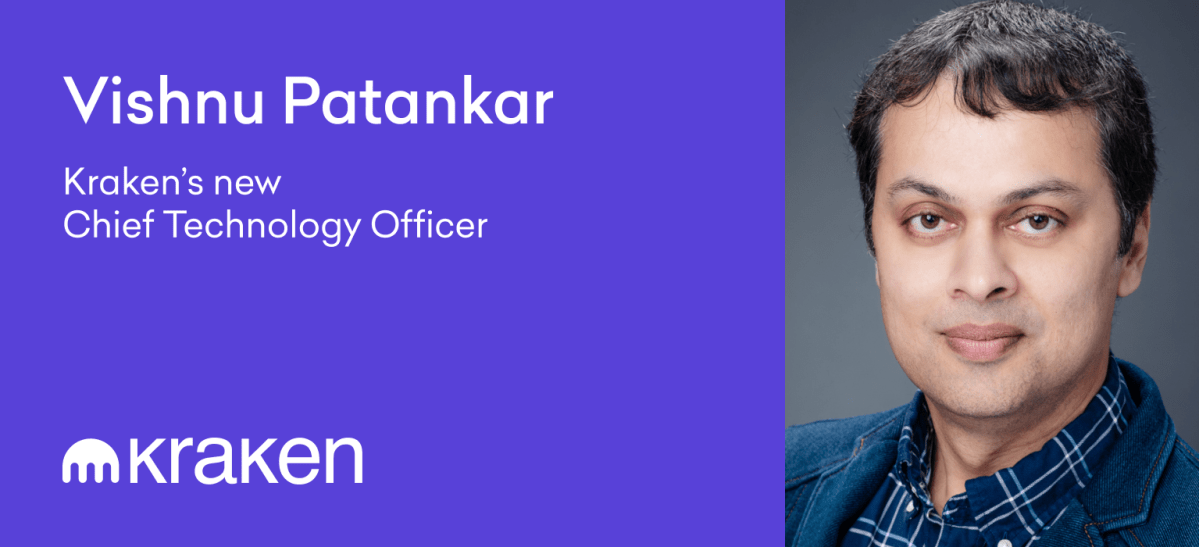Kraken, one of the world’s longest standing and most trusted crypto platforms, today announced the appointment of Vishnu Patankar as Chief Technology Officer (CTO). Patankar brings over twenty years of technology expertise to Kraken and helped Fortune 500 companies like Microsoft, Amazon, Intel, and Groupon to scale products that impacted millions of clients worldwide.
At Kraken, he will lead the engineering team and work with the company’s leadership to deliver the next generation of products and services. His focus will be on scaling the company into the most promising areas of crypto while maintaining its security-focused and client-obsessed ethos.
“Vishnu is a true leader in his field. He is a seasoned executive with deep expertise across all aspects of product development and tech leadership. He has built and led large, globally distributed engineering teams at some of the most innovative companies,” said David Ripley, Kraken CEO. “He’s a strategic and technical leader who is well equipped to build and optimize Kraken’s technology to deliver the most secure and scalable product experiences. We’re thrilled to have him join our team.”
An engineering leader with strong business acumen, Patankar helped build early scalable decentralized technologies by driving the development of products and infrastructure to service millions of clients around the world. Before joining Kraken, he was CTO at StockX where he played an integral part in facilitating the company’s growth and launching its NFT offering.
The Kraken Blog sat down with him to talk about his past and the future of the company under his leadership.
Kraken: You have a long and extensive history in tech, including “traditional” IT and cryptography. What drew you to cryptocurrency?
Patankar: I recently realized that I’ve worked with some aspects of blockchain technology for the past sixteen years – more than half of my nearly 25 years of experience. First, in 2006, we invented the world’s first industrial strength key-value store at Amazon, called Dynamo. The project used Merkle trees to validate data integrity. Then, in 2022, I helped launch the NFT offering for StockX. In fact, I’ve been involved with some core underpinnings of cryptocurrency and the blockchain itself for years, sometimes without realizing it!
Kraken: People often compare crypto today to late ’90’s tech. As someone who worked in both sectors at both times, do you think this is a useful/accurate analogy?
Patankar: The underlying mathematics of cryptography has largely remained stable. However, modern applications of cryptography have had dramatically wider reach.
One analogy I think works is the internet itself. It was hard to believe in the 1990s that an email message could transcend physical borders and make its way through a distributed naming system called DNS. If Web3 became as pervasive, the effects could be similar, if not even more important.
Kraken: What are you most interested in regarding Web3?
Patankar: The inclusivity of decentralized technologies like the blockchain itself is powerful. Outside the primary use case of digital currency, there is potential in tokenization applications using the blockchain in real estate, collectibles, art, vehicle titling, identity, healthcare and watermarking of AI training data.
Kraken: Out of the biggest tech companies, who is doing the most interesting work in crypto?
Patankar: The most work has happened at Meta. That’s not a surprise given their pivot to the metaverse and Web3. That said, the current macro environment is moderating adoption of some of that work, with a shift to AI applications through LLaMA. I also think that, due to the computational power being added to help with AI training by the largest cloud providers, there could be implications to the same power being harnessed by crypto.
Kraken: What are you looking forward to in 2023, technology-wise? Could AI play a role in crypto going forward?
Patankar: It’s hard to ignore the power of AI large language models. Although, it will be interesting to see what business models sustain through the initial hype cycle and journey to product-market fit, revenue and ebitda.
AI and cryptography are both probabilistic, albeit in different ways. So, for example, it might be okay to have a 90% correct answer from an AI chatbot, but there’s less use for a password that is 90% correct. Separately, there is early research on using AI to generate random numbers that can be used in cryptography although pseudorandom number generators still dominate.
More broadly, AI applied to customer experiences around crypto are in their infancy – for example, generative AI and personalization applied to NFTs. Other symbiotic areas between AI and crypto are cybersecurity and fraud prevention.
Beyond these, both AI and crypto explore large amounts of data through massive computational power. There are areas in computer science and physics that could lead to further breakthroughs over the next couple of decades. One area I’m excited by is quantum computing and its interplay with factorization of large numbers.
Kraken: What’s your five-year plan here at Kraken? What do you hope to be able to do here?
Patankar: Kraken is among the most trusted brands in crypto. Given this foundation, over the next five years, the mission is the focus – to expand and build products for the mainstream. This focus will mean scaling product offerings and power transaction scale far beyond our current rates. In order to achieve our mission, we will be scaling the platform into the most promising aspects of Web3, while still remaining true to our security focused and client obsessed ethos.
Kraken: If you could have dinner with one historical person, living, or dead, who would it be?
Patankar: Satoshi Nakamoto – I’d like to know whether he read the 2007 Dynamo paper and the piece around Merkle trees and the gossip protocol!
Source: https://blog.kraken.com/meet-krakens-new-chief-technology-officer-vishnu-patankar


